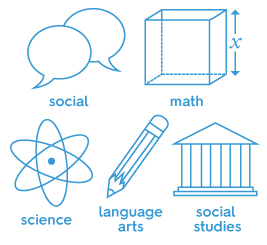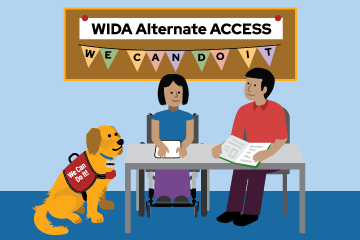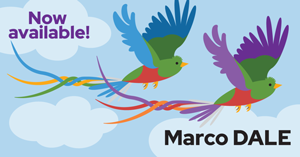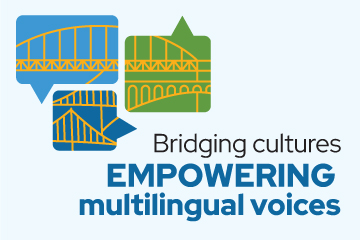Resources/Recursos
Featured Resources



All resources/Todos los recursos
Annual Technical Report for Alternate ACCESS for ELLs English Language Proficiency Test, Series 503, 2021-2022 Administration
Alternate ACCESS for ELLs technical reports provide evidence for validity and reliability of Alternate ACCESS for ELLs and support intended uses, interpretations and decisions made with the test.
This is the redacted report for the 2021-2022 administration of Alternate ACCESS for ELLs. Item information is removed from the report.
Resource Details View Download NowChoosing an Interim Assessment: Guidelines for Stakeholders
This document describes WIDA's viewpoint of the criteria for an assessment to be used as a valid interim English language proficiency assessment in support of the annual administration of ACCESS for ELLs.
Resource Details View Download NowCurricular Considerations: Introduction to Collaborating Around the 2020 Edition
The WIDA ELD Standards Framework, 2020 Edition brings new practical ways for all educators working with multilingual learners to conceptualize the development of content and language together through asset-based, equitable, and rigorous approaches in curricular design. This session will encourage participants to think about what collaboration looks like in these contexts.
Resource DetailsDesarrollando el español: Guiding bilingual instructional planning with Marco DALE
This webinar dives into the components of the Marco de los estándares del desarrollo auténtico del lenguaje español de WIDA (Marco DALE) and explores how they can support educator's planning processes.
Resource DetailsDesign Principles for Engaging Multilingual Learners in Three-Dimensional Science
WIDA and the National Science Teaching Association formed Making Science Multilingual to support equitable and inclusive forms of science instruction through which all students, but especially multilingual learners, can learn science and language simultaneously. To guide this work, the Making Science Multilingual team devised eight design principles to define the integration of contemporary three-dimensional science and language-in-use pedagogies. These principles will guide educator resource development at both organizations and facilitate critical examination of how well educator resources support inclusion of multilingual learners in rigorous science learning.
Resource DetailsDetection of Multiple Group Differential Item Functioning for Students with Disabilities of the Alternate ACCESS Field Tests in 2023
This report describe how WIDA applied Differential Item Functioning analysis among multiple disability groups of our Alternate ACCESS Field Test items in 2023.
Resource Details View Download NowDistrict Level Analysis of ELL Growth
This research project explored the patterns of district-level ELL “growth” for the 2007-2011 time period and identified the existence of “high-flying” and “low-cruising” districts within ACCESS for ELLs in terms of ELL growth.
Published May 2013
Author: Narek Sahakyan
Resource Details View Download Now
District Readiness to Implement Standards-Based Reform for English Language Learners a Decade After No Child Left Behind Act
This 16-state survey of school districts with fewer than 500 English language learners revealed that few district-level English language learner staff had formal preparation in educating English language learner or using English language proficiency standards. A wide school-level disparity existed between English as a second language or bilingual teachers and general education teachers in terms of their engagement with proficiency standards and assessment data.
Resource DetailsEnglish Language Arts
The purpose of this WIDA Focus Bulletin is to provide guidance to teachers of English language arts (ELA) who are implementing the Common Core State Standards (CCSS) and working to respond to the specific needs of ELLs. In their treatment of academic language (or the language of school), the CCSS represent a departure from existing content standards.
Published November 2013
Authors: Daniella Molle, Mariana Castro, Julia Cortada, Leslie Grimm
Evaluating Teacher Effectiveness Using ACCESS for ELLs
Regardless of the growth model, aggregate test-score-based models of student growth require large and longitudinally connected samples of student data. When sample sizes are small it becomes impossible to reliably estimate and disentangle district, school and teacher effects from student growth data.
Published June 2015
Author: Narek Sahakyan
Examination of Identification and Placement Decisions Made for K–12 English Learners
This study examines how 476 K–12 educators in 35 U.S. states identify and place English learners in language instruction educational programs. Findings reveal information about these educators, the instruments and information sources they use for decision making, and their perceived appropriateness of the decisions. Results provide practical implications for improving the English learner identification and placement decision at the district and school levels.
Resource DetailsExamining District-Level Growth Using ACCESS for ELLs
This research report provides a description of a study examining school districts in the WIDA Consortium whose English language learners (ELLs) exhibit consistently high growth on the ACCESS for ELLs (ACCESS) assessment.
Published August 2014
Authors: Narek Sahakyan, H. Gary Cook
Examining English Learner Testing, Proficiency and Growth: Before and Throughout the COVID-19 Pandemic
This report examines English learners’ (EL) testing, proficiency and growth in the academic years of 2018–19, 2019–20 and 2020–21, using population-level data from ACCESS for ELLs Online, administered across the WIDA Consortium to students identified as ELs. The objective of the report is to shed light on the impact of the COVID-19 pandemic on ELs’ educational outcomes.
October 2021
Authors: Narek Sahakyan, H. Gary Cook
Examining English Learner Testing, Proficiency, and Growth: Before, During, and “After” the COVID-19 Pandemic
This report examines English learner testing, proficiency, and growth in the years surrounding the COVID-19 pandemic. This research builds on an October 2021 report on the impact of the pandemic, and includes data from the 2021-22 ACCESS for ELLs test administration. Findings indicate that in some grades and language domains EL's average proficiency and growth have returned to pre-pandemic levels. However, for most grades and language domains the evidence points to a continuing impact of COVID-19 on English learners’ English language development.
Published April 2023
Author: Narek Sahakyan, Glenn Poole
Examining English Learner Testing, Proficiency, and Growth: Continued Trends since the COVID-19 Pandemic
This report examines English learners’ testing, proficiency, and growth during the six most recent academic years (2018-2023) to shed light on the continued impact of the COVID-19 pandemic on English learners’ educational outcomes. It provides descriptive evidence on disparities in outcomes within WIDA's English learner population, with substantial average differences in outcomes between English learners identified as Hispanic compared to non-Hispanic ELs. Findings show that these disparities are persistent and have been exacerbated by the COVID-19 pandemic.
Published April 2024
Authors: Glenn Poole, Narek Sahakyan
Examining Growth at the Intersection of IEP and (Long-Term) EL Status
Motivated by findings of a 2018 WIDA report pointing to large overlap between ELs with Individualized Education Program (IEP) designations and those ELs who could be identified as LTELs, this study further focuses on these dual-identified students. Grouping ELs by ever-IEP (i.e., being assigned an IEP at any point in the longitudinal record) and never-IEP status, we compare these two subgroups’ English language growth trajectories across time. Our findings show consistent trends of differential growth and reclassification rates for these two subgroups.
Published November 2021
Authors: Narek Sahakyan, Glenn Poole
Examining Preschool-aged Dual Language Learners’ Language Use: From a Functional Approach
This study examines oral language development of 14 dual language learners ages 2.5 to 5.5 years in preschools in the Midwestern United States. They engaged in five key language uses: argue, explain, heuristic, recount, and request. Preschoolers 2.5 to 3.5 years only made simple requests or argued to meet their needs; the older cohort demonstrated a wider range of key language uses.
Resource DetailsExamining Relationships Between Alternate Access and State Alternate Assessments
This report examines how Alternate ACCESS for ELLs serves as a tool that identifies English proficiency attainment for English learners with significant cognitive disabilities.
Published December 2014
Author: H. Gary Cook
Examining the Relationship Between the WIDA Screener and ACCESS for ELLs Assessments
This report describes a study that examined to what extent scores on WIDA Screener predict scores on ACCESS for ELLs. Researchers found that Screener scores are strongly predictive of ACCESS scores, even when a variety of individual factors are accounted for.
Published February 2020
Authors: David MacGregor, Narek Sarakyan
Expanding Reading Instruction with Multilingual Learners
Across the country, educators are working to improve students' reading, but many of the programs and approaches in use were not designed to take into account the unique needs and assets of multilingual learners. This Focus Bulletin shares classroom-ready resources, as well as examples and video from classrooms where educators are working to expand reading instruction to make it more inclusive and more effective for multilingual students.
Resource Details View Download Now



